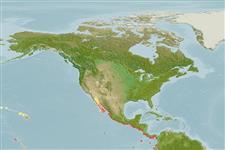>
Carangaria/misc (Various families in series Carangaria) >
Centropomidae (Snooks)
Etymology: Centropomus: Greek, kentron = sting + Greek, poma, -atos = cover, operculum (Ref. 45335).
More on author: Günther.
Environment: milieu / climate zone / depth range / distribution range
Ekologi
marina; sötvatten; brackvatten bottenlevande. Tropical; 29°N - 0°N, 113°W - 77°W
Eastern Pacific: southwestern coast of Baja California Sur, Mexico and the central Gulf of California to Ecuador.
Size / Vikt / Age
Maturity: Lm ? range ? - ? cm
Max length : 65.0 cm TL hane/ej könsbestämd; (Ref. 55763); common length : 30.0 cm TL hane/ej könsbestämd; (Ref. 55763); publicerad maxvikt: 3.2 kg (Ref. 40637)
Body slender and not very deep; dorsal profile slightly concave behind the eyes; lateral line extending to posterior edge of caudal fin; second anal spine, when folded down, not reaching origin of caudal fin; pectoral fins shorter than pelvic fins; anal fin with 7 rays; back blue or gray; belly silvery; lateral line dark. Membranes between second and third anal spines black; distal quarter of pelvic fins generally dark (Ref. 55763).
Adults inhabit bays and estuaries (Ref. 37955). Also found in high altitudes of at least 250 m elevation and a distance of some 20 km from the coast. They also occur in coastal waters, but is more abundant in estuaries of any size. Enter freshwaters mostly in large rivers and feeds on fish and crustaceans (Ref. 36880).
Life cycle and mating behavior
Könsmognad | Reproduktion | Lek | Ägg | Fecundity | Larver
Bussing, W.A., 1995. Centropomidae. Róbalos. p. 987-995. In W. Fischer, F. Krupp, W. Schneider, C. Sommer, K.E. Carpenter and V. Niem (eds.) Guia FAO para Identification de Especies para lo Fines de la Pesca. Pacifico Centro-Oriental. 3 Vols. FAO, Rome. (Ref. 9284)
IUCN Red List Status (Ref. 130435)
Warning: mysqli::__construct(): (08004/1040): Too many connections in /var/www/html/includes/func_getlabel.php on line 46
Can't connect to MySQL database (fbapp). Errorcode: Too many connections
